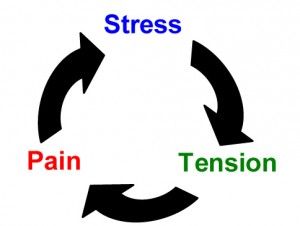We are embodied, that is, we experience everything in life through our body. Our mind and body work together to support us in the daily experiences of living. Yogis have understood our mind-body connection for thousands of years. In yogic terms, there is no separation between mind, body, and spirit; the three are in “union” (one definition of the word yoga). What happens in the mind also happens in the body and spirit and vice-versa. At times unresolved emotional experiences are stored as tension in the body, in the unconscious mind as coping strategies and/or show up in our lives as patterned behaviors that may no longer be supportive. Overtime we can become constricted in the ways we both move and think.
Fear-Based Tension and the Body
So how does tension become stored in our body? We can experience a feeling of stress by either a real or perceived threat and stress creates a feeling of fear. When our body feels threatened, it shifts into the “fight or flight” response, the evolutionary reaction that prepares the body for great physical exertion, getting us ready to fight the proverbial lion. As our body goes on red alert for danger, our heart rate increases, blood pressure rises, and stress hormones, like cortisol and adrenaline, flood our body.
In situations where running and/or fighting are inappropriate, adrenaline, with no accompanying physical exertion to burn it off, creates by-products which are stored in the body, particularly in the major muscle groups, like the shoulders, neck, hips and legs. Just as unexpended calories result in stored fat, unexpended adrenaline by-products result in stored tension.
The changes experienced by the body during traumatic and overwhelmingly stressful experiences have become clearer over the past few years because of breakthroughs in brain scans like functional magnetic resonance imaging (fMRI), which enables scientists to look at how the brain functions in real time. A key finding from these brain scans is that during traumatic stress, the speech center shuts down. This explains why many people cannot completely put into words what happened to them and highlights a limitation in using talk therapy alone in helping someone fully recover from overwhelming stress.
Therapy on the Mat
Because fear-based tension and trauma have so many physical effects, it is important to include our body in emotional healing and include processes that enable our body to feel safe again. Phoenix Rising Yoga Therapy, “yoga for emotions,” offers such an opportunity as it was created to help people process and cope with stored emotional stress.
PRYT is a complete system of somatic yoga therapy and a great modality to complement traditional talk therapy. Based on the Rogerian principals including “person-centered therapy” and “unconditional positive regard,” the client direct the focus of the session while the Phoenix Rising practitioner meets the client where they are while accepting them unconditionally without passing judgments on his/her actions, feelings or attitudes. Combining assisted yoga postures, breath awareness, and nondirective dialogue, the practitioner acts as a mirror to the client, mirroring and repeating much of what the client says to support the her/him in staying present to real time experience.
By supporting clients in experiencing the present moment, including emotions, thoughts, sensations, images, and whatever arises, Phoenix Rising helps people recognize their body’s own wisdom and get to the source of emotions that may be causing aches and pains, physically, emotionally or mentally. Phoenix Rising Yoga Therapy offers the opportunity of knowing through full embodiedment, which is to know with your whole being—body, mind, and spirit—to support the healing of the whole individual.
For more information about or to contact Lori VanBuggenum visit embodiedyogatherapy.com


